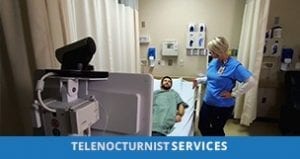Program Will Feature How Telenocturnist Care Is a Sustainable Approach That Helps Small Rural Hospitals and Larger Facilities Solve Nighttime Staffing Challenges, Close Gaps in Coverage
ATLANTA—Aug.1, 2016—The benefits of using telemedicine to close nighttime staffing gaps at hospitals will be the topic of a webinar sponsored by the National Rural Health Association and Eagle Telemedicine, an industry pioneer solving hospital challenges through a variety of innovative telemedicine solutions.
“Telemedicine Night Coverage Solutions: Why They Work for Hospitals and Physicians” is scheduled for 3 p.m. EDT on Thursday, Aug. 4. Register here. Admission is free.
“Staffing has become a systemic problem for many hospitals,” said Talbot “Mac” McCormick, MD, President and CEO of Eagle Telemedicine and Eagle Hospital Physicians, and webinar presenter. “Band-aid approaches might work for the short term, but telemedicine offers a more sustainable solution for rural hospitals, as well as larger hospitals that need help with nighttime ED admissions and cross-coverage.”Participants will learn how:
- Telenocturnist care by remote physicians can leverage night staffing and prevent night calls—and burnout—for local physicians.
- Telecross-coverage by remote physicians covering floor calls can keep ED nocturnists focused on admissions and ease stress levels.
- Remote physicians backing up NPs and PAs can strengthen collaborative care in hospitals, and relieve the pressure to hire physicians to share night shifts.
Night coverage solutions a new area of telemedicine growth
In telemedicine, a robot on a rolling stand is equipped with a digital stethoscope and other diagnostic equipment, as well as a teleconferencing monitor and camera that enable physicians from remote locations to communicate directly, face to face, with hospital patients and staff. Working behind the scenes is a cloud-based telehealth network that enables the connection between patient and physician, and a small team of telemedicine physicians specifically assigned to a particular hospital.
 “Telemedicine is helping boost patient census for rural hospitals by enabling them to provide care for more patients on-site rather than transferring them to larger facilities miles away,” said Dr. McCormick. “With telemedicine physicians always on hand at night via teleconferencing and remote diagnostic technology, critical decisions can be made quickly without having to wait until morning, when daytime physicians begin their day.”
“Telemedicine is helping boost patient census for rural hospitals by enabling them to provide care for more patients on-site rather than transferring them to larger facilities miles away,” said Dr. McCormick. “With telemedicine physicians always on hand at night via teleconferencing and remote diagnostic technology, critical decisions can be made quickly without having to wait until morning, when daytime physicians begin their day.”
Larger hospitals in metropolitan areas also see benefits. “Nocturnists often have to be in two places at once in busy hospitals: handling admissions, rounding on patients in the ED, and providing cross-coverage consultations to patients on the floor,” said McCormick.“Stress and burnout can run rampant. It’s the reason we’re seeing widespread interest from mid-size and large hospitals in Eagle telecross-coverage programs that were designed to support their night coverage teams.”
With telecross-coverage, Eagle physicians can remove the burden of floor calls and consultations from onsite ED noctunists, and are also available to help with ED admissions during peak periods. “We’re excited about this relatively new application for telemedicine in the hospital setting,” Dr. McCormick said. “We look forward to sharing details about our telenocturnist solutions—and the hospital industry’s growing interest in them—with webinar attendees.”